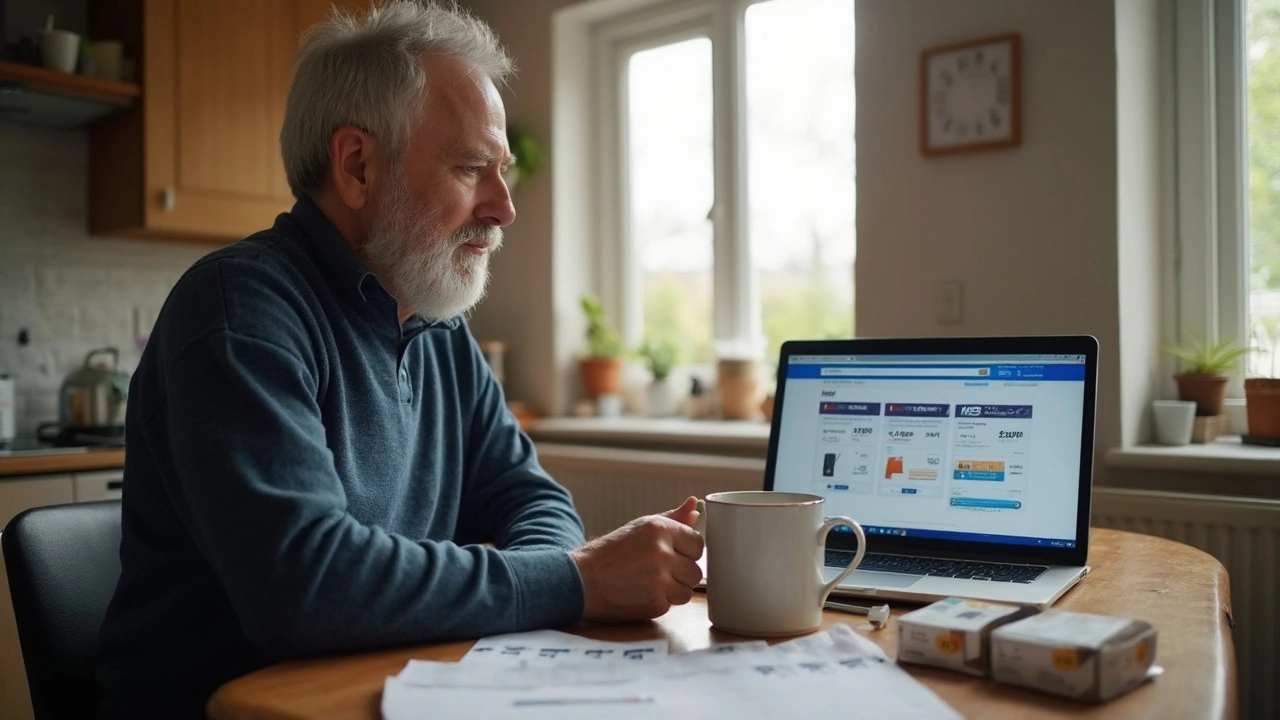Why Inhalers for COPD Cost So Much—and Where Your Money Goes
Ever feel like every time you refill your COPD inhaler, your bank account takes a hit? You're not alone. The sticker shock at the pharmacy counter is real, and there are some surprising reasons behind it. First, COPD inhalers aren't your typical pill-in-a-bottle. They're engineered medical devices that deliver medication straight to your lungs—no detours, no guesswork. Designing, testing, and mass-producing these inhalers isn't cheap. Manufacturers invest millions in research, development, and clinical trials just to get the go-ahead from health authorities. On top of that, brand-name drugs often come with patents that block generic competition for years, keeping prices stubbornly high. Did you know that newer combination inhalers can run up to $400 or more for a month's supply without insurance? That's not a small ask for most people.
Insurance coverage is a wild card, too. Depending on your plan, some inhalers might cost you a modest copay, while others hit you with the full retail price. And if you're on Medicare Part D, there's that infamous "donut hole" where your out-of-pocket costs spike. The truth is, inhaler pricing is tangled in a web of patents, exclusive supply contracts, and negotiated rebates. One often-overlooked cost-driver? The device itself. Metered-dose inhalers (MDIs) have built-in propellants and valves, dry powder inhalers (DPIs) have special chambers for powder dispersal, and soft-mist inhalers use precision engineering for fine, breathable sprays—all of which adds complexity and, you guessed it, cost.
If it feels unfair that critical medications like COPD inhalers are this pricey, you're not wrong. In the United States, drug prices are some of the highest globally—often three to four times more than what folks pay in the UK, Canada, or Australia. Partly, that's because the U.S. lets pharma companies set their own prices, while other countries negotiate lower prices or set spending limits. But don't throw in the towel just yet; there are ways to knock those costs down, from generic brands to patient assistance programs. So, let's talk about what actually matters when picking a budget-friendly inhaler.
What Really Matters in a Maintenance Inhaler: Efficacy, Safety, and Convenience
Choosing a cheap inhaler sounds great—until you wonder if going cheap means short-changing your health. Not every bargain-bin inhaler is created equal, and your lungs deserve the best shot at feeling good. So what separates a smart affordable choice from a dud? Let's break it down.
The big three factors are efficacy, safety, and convenience. If your inhaler doesn't control symptoms and keep flare-ups at bay, it's not worth saving a buck. Clinical studies show that many generic inhalers use the exact same active ingredients as expensive brands—think budesonide/formoterol for Symbicort, or fluticasone/salmeterol for Advair. As long as the dosage and delivery are comparable, generics can be just as effective. Want proof? The FDA requires all generic inhalers to show "bioequivalence," which means your body absorbs the medicine at the same rate as the brand version. In 2023, the FDA approved the first fully interchangeable generic for Advair Diskus, and many patients reported equal symptom relief at a fraction of the cost.
Safety's next. Generics have to meet strict manufacturing standards. Side effects, efficacy, and even inhaler performance get close scrutiny because a device that misfires or delivers the wrong dose could spell trouble. Still, some inhalers take a bit of practice—MDIs require coordinated breathing and hand pressure, while DPIs only work well if you're able to create a strong inhale. If you have arthritis or shaky hands, talk to your doctor about which designs you'll find easy to handle consistently. Seniors often have better results sticking to what they're already familiar with—especially if they use spacers or dose counters.
Convenience isn't trivial either. Does your inhaler fit your lifestyle? Some need daily rinsing, others have built-in dose counters or need to be kept at room temperature. If you travel or work long hours, portability and durability matter. The bottom line? Even if you're saving money, make sure your inhaler slides easily into your day—and keeps symptoms at bay. The best budget-friendly inhaler is the one you'll actually use, every single time.

Smart Strategies for Finding an Affordable COPD Inhaler
Here comes the good stuff—real tips that work when you're determined to save cash without losing out on quality. Start by talking to your healthcare provider. Most doctors are up to speed on cost-effective options and can write a script for the generic before you ask. Don't be shy about mentioning cost; doctors hear this problem all the time and can tailor a plan that fits your budget and medical needs. In some cases, switching to a different type of inhaler—say, from a brand-name combination inhaler to a metered-dose generic—can cut your monthly costs in half or more.
Pharmacies aren't all created equal, either. Prices vary wildly, and local independents sometimes offer lower cash prices than the big chains. Online tools like GoodRx or WellRx let you compare prices in your area in seconds. Mobile apps show that one pharmacy might charge $60 for the same inhaler that costs $200 across the street—no joke. Some pharmacies offer loyalty programs or membership discounts that can shave another chunk off your bill.
Ever thought about shopping across the border? Many savvy folks look for international pharmacies, especially in Canada. Canadian pharmacies can sell mail-order inhalers for less than half the U.S. price, and they sell many of the same FDA-approved drugs. For those considering a cheaper alternative to Symbicort, it's worth exploring these options—just make sure the site is licensed and legit. Some American insurance plans even work with overseas pharmacies for long-term medications.
Another underused trick is to look for manufacturer coupons or patient assistance programs. Big pharma companies know their prices are a problem, particularly for those with high-deductible plans or no insurance at all. Drug manufacturers' websites often have printable coupons or rebates, and some even offer free or deeply discounted inhalers if you meet income guidelines. Hospitals and community health clinics can steer you toward these programs; you just need to ask.
Don't forget about split dosing or alternate therapies. Sometimes, using a single-drug inhaler for routine control and keeping a fast-acting rescue inhaler for flares saves big compared to always staying on the pricier dual inhalers. If your symptoms are stable, ask if stepping down your therapy is safe—and if your prescription can be filled with a more affordable regimen. Your lungs—and your wallet—will thank you.
Comparing Inhaler Types: Brands, Generics, and Over-the-Border Alternatives
Let's get specific with the actual drugs and devices out there. When it comes to maintenance inhalers for COPD, you have three broad categories: long-acting beta-agonists (LABAs), inhaled corticosteroids (ICS), and anticholinergics—sometimes all rolled into combination inhalers. The blockbuster brands are familiar: COPD inhalers like Symbicort (budesonide/formoterol), Advair (fluticasone/salmeterol), Breo Ellipta, Spiriva (tiotropium), and Combivent (albuterol/ipratropium).
Here's where generics start to shine. Budesonide/formoterol is now available in generic versions that cost 60-70% less than Symbicort. Generic Advair Diskus came on the market in 2023, bringing prices down for patients who were shelling out $300 a month. Even futuristic Ellipta inhalers—think Breo or Anoro—have seen some price drops thanks to competitors. Pharmacy discount cards and insurance formularies often favor these generics, but it's worth double-checking that your plan covers the option you want.
If money's super tight, over-the-border solutions are a lifeline. Canadian and UK pharmacies stock the same active drugs under different brand names: "Seretide" is Advair, "Pulmicort" is budesonide, "Simbicort" (yes, with an "i") is Symbicort for EU and Australia. Be sure to compare milligram strengths and be honest with your doctor about where you're getting your meds. With mail-order services and e-prescribing, refilling from Canada has become safer and more streamlined than ever for U.S. consumers.
Here's a quick look at average monthly costs for popular COPD inhalers in 2024:
| Brand Name | Generic Option? | Typical U.S. Price | Canada Price |
|---|---|---|---|
| Symbicort | Yes | $350+ | $80-$120 |
| Advair Diskus | Yes | $320+ | $90-$110 |
| Breo Ellipta | No | $360+ | $110-$140 |
| Spiriva | Limited | $400+ | $110-$130 |
Don't get tripped up by device differences. Some generic inhalers look—and feel—nothing like their brand-name cousins. If you've only ever used Diskus but your new generic is a pressurized inhaler, make sure you're comfortable using it. Pharmacists can demo the proper technique and even let you practice with a sample. Never be embarrassed about asking for a run-through; using your inhaler correctly is what makes the medication work as intended. That, more than anything, is what you want: relief you can trust, every time you take a breath.

Spotting Hidden Fees and Maximizing Your COPD Inhaler Savings
This is where dollars can sneak away if you're not careful. One frustrating reality is pharmacy "dispensing fees"—small add-ons that pile up, especially with multiple monthly fills. Some mail-order pharmacies offer 90-day supplies for less than three 30-day fills, so consider asking your doctor to write a script that allows for bulk filling. You might also save by buying two-inhaler packs, which can give you a better per-unit price (great for folks keeping one at home and one in a travel bag).
Formulary changes are another trap. Insurers update their covered drug lists yearly, sometimes dropping your go-to inhaler for a "preferred" alternative. The result: surprise costs that hit at the pharmacy window. Keep tabs on your plan's formulary and ask your pharmacist if a change is coming up. If so, ask your doctor to preemptively switch you to something that will stay covered, or get prior authorization if you have a strong medical need for your current device.
Some people get burned by expired copay cards or coupons that only cover the first few fills. Check expiration dates and always read the fine print—some discounts are one-time-only, while others can be reused for years. Online communities and advocacy groups share up-to-date coupon codes and tips, so joining a COPD support network can keep you in the loop and save a few bucks, too.
If you do get stuck with a big out-of-pocket bill, ask the pharmacist if they can run your prescription as "cash pay" to see if you qualify for a lower base price. Pharmacies don't always tell you if paying outside insurance is cheaper, but you can always ask. For those without insurance, some community clinics and hospital systems partner with nonprofit pharmacies that provide medications at cost or even for free. Don't assume you're out of options—even if your financial situation is tough, there are resources that can get you the care you need.
And a last word to the wise: always track your refills and ask about any "emergency supply" options, so you never run out of medication. Missing doses—especially with COPD—isn't just uncomfortable; it can lead to breathing problems that land you in the ER, which costs way more than any inhaler refill ever could. Stay ahead, stay informed, and don't be afraid to shop your options—your breathing depends on it, but your wallet will breathe easier, too.


Marcia Martins
May 5, 2025 AT 05:57Robert Bowser
May 6, 2025 AT 03:14Sue M
May 6, 2025 AT 09:40Rachel Harrison
May 6, 2025 AT 19:17Tiffanie Doyle
May 7, 2025 AT 16:33james landon
May 8, 2025 AT 12:03Jenn Clark
May 9, 2025 AT 02:10L Walker
May 9, 2025 AT 16:08giri pranata
May 9, 2025 AT 19:14Stuart Rolland
May 10, 2025 AT 07:02Kent Anhari
May 10, 2025 AT 15:02Charlos Thompson
May 10, 2025 AT 21:45Peter Feldges
May 11, 2025 AT 05:58Rohit Nair
May 11, 2025 AT 23:05